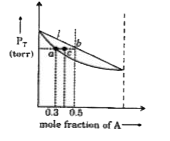The vapour pressure of water is 92.5 mm at 300 K. The V.P. of 1 molal aqueous solution of non volatile non electrolyte solute isSolution in Malayalam
90.86 mm
87.32 mm
69.50 mm
53.21 mmZ
The correct Answer is:A
P∘A−PsP0A=nBnA+nB
92.5−Ps92.5=11+100018
Ps=90.84mm
Topper's Solved these Questions
- BOOK - BRILLIANT PUBLICATIONCHAPTER - SOLUTIONSEXERCISE - Level II50videos
SOLUTIONS
- BOOK - BRILLIANT PUBLICATIONCHAPTER - SOLUTIONSEXERCISE - Level II (Assertion & Reason Type)20videos
SOLUTIONS
- BOOK - BRILLIANT PUBLICATIONCHAPTER - SOLUTIONSEXERCISE - Level-III (Linked Comprehension Type)12videos
SOLUTIONS
- BOOK - BRILLIANT PUBLICATIONCHAPTER - SOLID STATEEXERCISE - LEVEL-3 (Linked Comprehension Type)10videos
SOLID STATE
- BOOK - BRILLIANT PUBLICATIONCHAPTER - STEREOCHEMISTRY EXERCISE - LEVEL-II (ASSERTION - REASON TYPE)2videos
STEREOCHEMISTRY
Similar Questions
The volumes of two HCl solutions A (0.5N) and B(0.1N) to be mixed for preparing 2 L of 0.2 NHCl are:
01:43View SolutionAssertion : If a liquid solute more volatile than the solvent is added to the solvent, the papour pressure of the solution may increase i.e. ps>p∘.
Reason In the presence of a more volatile liquid solute, only the solute will form the vapours and solvent will not.05:06View Solution1 mole of A and 1 mole B are mixed together to form an ideal solution at 25∘C. Solution is placed in a vessel fitted with piston. If pressure on the solution is reduced isothermally.

Correct relationship between P∘AandP∘B is03:17View SolutionF centre is an example of metal excess defect due to the presence of extra cations at interstitial sites. Zinc oxide is white in colour at room temperature, on heating it loses oxygen and turns yellow.
ZnOHeat−−→Zn2++12O2+2e−
Now there is excess of zinc in the crystal and its formula becomes Zn1+x O. the excess of Zn2+ ions move to interstitial sites and the electrons to neighbouring interstitial sites.
There are many solids which are difficult to prepare in the stiochiometric composition and contain less amount of the metal as compared to stiochiometric proportion. a typical example of this type is FeO which is mostly found with a composition of Fe0.95. it may actually range from Fe0.96 O.
Q. In Fe0.95 O:03:15View SolutionAssertion : Meso tartaric acid is optically inactive
Reason : Meso tartaric acid has a plane of symmetry04:48View SolutionFind the molality of a solution containing a non-volatile solute if the vapour pressure is 2% below the vapour pressure or pure water.
05:06View SolutionThe relative lowering of vapour pressure of an aqueous solution containing a non-volatile solute, is 0.0125. The molality of the solution is
05:31View SolutionThe vapour pressure of water is 12.3kPa at 300 K. The V.P. of 1M solution of a non-volatile non electrolyte solution is
View SolutionLowering of vapour pressure of an aqueous solution of a non-volatile non-electrolyte 1 m aqueous solution at 100^(@)C is,
View SolutionThe vapour pressure of water is 12.3 k Pa at 300 K. Calculate the vapour pressure of 1 molal solution of a non-volatile solute in it.
01:56View SolutionThe vapour pressure of 2.1% solution of a non- electrolyte in water at 100∘C is 755 mm Hg. Calculate the molar mass of the solute .
02:15View Solution300 K पर, जल का वाष्प दाब 12.3 किलो पास्कल है। इसमें अवाष्पशील विलेय पदार्थ के एक मोलल विलयन का वाष्प दाब ज्ञात कीजिए।
02:52View SolutionThe vapour pressure of water is 12.3 Kpa at 300K. Calculate vapour pressure of 1 molal solution of a non-volatile solute in it.
03:06View SolutionThe vapour pressure of water is 12.3 kPa at 300 K. Calculate the vapour pressure of 1 molal solution of a non-volatile solute in it
02:14View SolutionThe vapour pressure of water is 12.3 kPa at 300 K. Calculate vapour pressure of 1 molal solution of a non - voltaile solute in it.
02:31View Solution

